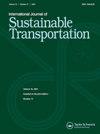Cycling accessibility to employment, schools, and grocery stores in Arizona metropolitan regions
IF 3.1
3区 工程技术
Q2 ENVIRONMENTAL STUDIES
International Journal of Sustainable Transportation
Pub Date : 2025-02-01
DOI:10.1080/15568318.2025.2460637
引用次数: 0
Abstract
The further motivation of bicycling as a utilitarian travel alternative has been identified as a viable solution to address societal concerns regarding physical inactivity, climate change, and transportation inequities. Yet, a profound increase in bicycling activity for many cities remains elusive to policymakers, practitioners, and researchers largely because of the inability to attract new bicyclists via safer bicycling infrastructure provision. To better understand current bicycling barriers to its future adoption, this study describes the advancement of the Cyclist Routing Algorithm for Network Connectivity (CRANC) and its application as an accessibility-oriented transportation planning tool in eight Arizona metropolitan regions. CRANC, an innovative bicyclist routing platform sensitive to bike network conditions and the varying traffic safety concerns of cyclist types (interested but concerned, enthused and confident, strong and fearless), is designed to support utilitarian bicycling promotion by identifying its latent demand. In this application, local and regional discrepancies in bicycling accessibility to jobs, schools, and grocery stores are identified and visualized by integrating the concepts of cyclist types and bicycle level of traffic stress into a new bicycling accessibility metric. Study findings show significant differences in place-based bicycling accessibility across key sociodemographic and economic indicators for the interested but concerned cyclist type, who prefers dedicated bike facilities, slower vehicle speeds, and lower traffic volumes. A recognition of these variations is important for promoting equitable bicycling access to subsistence and maintenance activities for those individuals who do not presently use this sustainable mode but would if barriers to access were removed.
在亚利桑那州的大都市地区,骑车可达就业、学校和杂货店
骑自行车作为一种实用的出行选择的进一步动机已被确定为解决缺乏运动、气候变化和交通不平等等社会问题的可行解决方案。然而,对于政策制定者、实践者和研究人员来说,许多城市骑自行车活动的大幅增加仍然是难以实现的,这主要是因为无法通过提供更安全的自行车基础设施来吸引新的骑自行车者。为了更好地了解当前的骑车障碍对其未来采用的影响,本研究描述了骑车者网络连接路由算法(CRANC)的进展及其在亚利桑那州八个大都市区作为可达性导向交通规划工具的应用。CRANC是一个创新的自行车路线平台,它对自行车网络条件和不同类型的自行车骑行者(感兴趣但关注,热情而自信,强壮而无畏)的交通安全问题敏感,旨在通过识别其潜在需求来支持功利主义的自行车推广。在这个应用程序中,通过将骑自行车的类型和自行车的交通压力水平的概念集成到一个新的自行车可达性指标中,可以识别和可视化骑车到工作、学校和杂货店的地方和区域差异。研究结果表明,对于有兴趣但关心骑行的类型,他们更喜欢专用的自行车设施、较慢的车速和较低的交通量,在关键的社会人口和经济指标上,基于地点的自行车可达性存在显著差异。认识到这些差异对于促进那些目前不使用这种可持续模式但如果消除障碍就会使用这种模式的个人公平地骑自行车获得生存和维持活动是很重要的。
本文章由计算机程序翻译,如有差异,请以英文原文为准。
求助全文
约1分钟内获得全文
求助全文
来源期刊
CiteScore
8.90
自引率
2.60%
发文量
56
期刊介绍:
The International Journal of Sustainable Transportation provides a discussion forum for the exchange of new and innovative ideas on sustainable transportation research in the context of environmental, economical, social, and engineering aspects, as well as current and future interactions of transportation systems and other urban subsystems. The scope includes the examination of overall sustainability of any transportation system, including its infrastructure, vehicle, operation, and maintenance; the integration of social science disciplines, engineering, and information technology with transportation; the understanding of the comparative aspects of different transportation systems from a global perspective; qualitative and quantitative transportation studies; and case studies, surveys, and expository papers in an international or local context. Equal emphasis is placed on the problems of sustainable transportation that are associated with passenger and freight transportation modes in both industrialized and non-industrialized areas. All submitted manuscripts are subject to initial evaluation by the Editors and, if found suitable for further consideration, to peer review by independent, anonymous expert reviewers. All peer review is single-blind. Submissions are made online via ScholarOne Manuscripts.

 求助内容:
求助内容: 应助结果提醒方式:
应助结果提醒方式:


